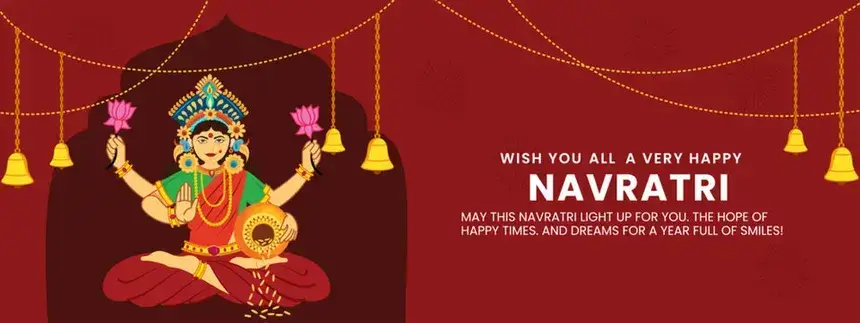Shardiya Navratri 2023

Navratri is the most important festival for Hindus. It is more than just a festival; it is a celebration of faith, devotion, and togetherness. Navratri occurs four times a year, once in each season: Vasant Navratri in spring, Ashad Navratri in summer, Sharad Navratri in autumn, and Magh Navratri in winter. Among these, Sharad Navratri is the most popular and is celebrated widely with great enthusiasm by Hindus all over the world. Shardiya Navratri is the longest-celebrated festival, which continues for ten days and during which various forms of Maa Durga are worshiped. The tenth day is Vijayadashami, which is the most important day of this Navratri.
Like most Hindu festivals, Navratri also has many folk tales attached to it. The most popular story is about the battle between Maa Durga and the demon king Mahishasur. The war continued for nine days, and each day Maa Durga took on a new form, and on the tenth day, she finally achieved victory. These nine forms, called Navdurga, are worshipped during Navratri. This event is mentioned in the chapter `Devi Mahatya`` of the Markandeya Purana.
This festival also commemorates the victory of Lord Rama over Ravana. Rama was advised to worship the goddess to ensure his victory over Ravana. This battle also continued for nine days, and each day Rama worshipped a distinct form of Maa Durga. He finally defeated Ravana on the tenth day, which is celebrated as Dussehra or Vijayadashmi and signifies the triumph of good over evil.
Bharat is known for its varied cultures. Here, festivals are celebrated in a wide variety of ways depending on their region, local history, and family influences. Navratri is a beautiful example of unity in diversity, as each region has its own way of celebrating this festival. The way of celebrating may be different, but it all centers around one thing: worshipping the mother goddess.
In the northern states, these nine days are filled with special pujas, yajnas, fasting, and singing devotional music. On the eighth and ninth days, young girls are invited as Devis and offered food and gifts.
Dussehra is the focal point of this Navratri. In many places, Ramleelas are organized where the story of Lord Rama is enacted. On the tenth day, the edifices of Ravana and his brothers are burned to mark the victory of good over evil.
In the western state of Gujarat, Navratri is celebrated with utmost enthusiasm. The highlight of the festival is Garba, the traditional dance. Each evening, hundreds of men and women get together wearing colorful clothes to perform Garba and Dandiya Raas. This vibrant culture is fast becoming popular in other states as well.
In West Bengal and other eastern states, the festival is observed as Durga Puja. Here, the last five days are important. It is believed that Maa Durga visits her home with her children to bless her devotees. Huge pandals are set up, and life-size idols of Maa Durga are installed along with Ganesha, Kartikeya, Lakshmi, and Saraswati. These pandals are a showcase of creativity. This is a fun time in Bengal, with people catching up with friends and relatives, wearing new clothes, pandal hopping, and enjoying meals out. The most interesting thing about the puja is the Dhunuchi Naach, which is performed in the evening. Both men and women take part in it. They hold earthen pots filled with burning charcoal and dance to the beats of the drum.
In the southern state of Andhra Pradesh, this festival is known as ‘Batukamma Panduga,’ which means “come alive, Mother Goddess.” Women make beautiful flower stacks arranged with seasonal flowers, called Batukamma. They dress up in new clothes and pray to Bathukamma. On Vijayadashami, it is set afloat in the river to mark the end of the festival.
In Tamil Nadu, it is the time to display the Kolu dolls. Kolu is a staircase with nine treads, representing the nine nights of Navratri. These stairs are decorated with dolls and idols of gods and goddesses. These Kolu toys are passed down to the next generation. Friends and relatives are invited to see the Kolu decoration.
In the southernmost state of Kerala, the last three days are more important. It is the time of Vidyaarambham, which means the beginning of education. It marks the day of formal education for every child in Kerala. On the evening of Maha Ashtami, ‘Pooja Vaippu’ is performed when all the books and tools are submitted in front of the goddess Saraswati. The next day, Saraswati Puja is done. On Vijayadashmi, young children are made to write alphabets on sand or grains of rice as a mark of the beginning of learning. People offer gifts to their teachers and seek their blessings.
Dussehra is the most important festival in Karnataka. The city of Mysuru, has a 400-year-long tradition of celebrating it, as was done by the Vijayanagara kings. The night-long dance known as ‘Yakshgana’ and epic drama from Puranas are enacted during the nine nights. On this occasion, the Mysuru Palace is beautifully illuminated, and cultural programs are held. The center of attraction is the procession of Chamundi Devi, which is taken out on the ninth day.
Navratri is considered auspicious and is believed to bring happiness and prosperity. Apart from its religious significance, there is a scientific reason as well. This is the time when the weather is changing and there is a shift in season. This change can affect our body and mind. Fasting and following a specific diet help to maintain good health. Singing and dancing help to reduce stress.